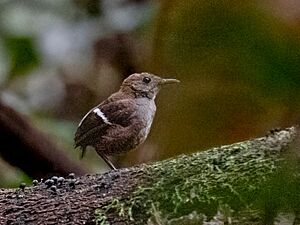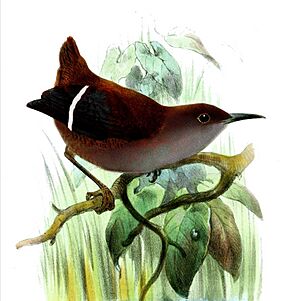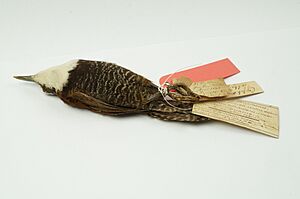Wing-banded wren facts for kids
Quick facts for kids Wing-banded wren |
|
|---|---|
 |
|
| Conservation status | |
| Scientific classification | |
| Genus: |
Microcerculus
|
| Species: |
bambla
|
 |
|
| Synonyms | |
|
Formicarius bambla (protonym) |
|
The wing-banded wren (Microcerculus bambla) is a small bird that belongs to the Troglodytidae family, also known as wrens. This bird is found in several countries in South America. You can spot it in Brazil, Ecuador, French Guiana, Guyana, Peru, Suriname, and Venezuela.
Contents
About the Wing-banded Wren
The wing-banded wren was first described in 1779 by a French scientist named Georges-Louis Leclerc, Comte de Buffon. He wrote about it in his book Histoire Naturelle des Oiseaux. Later, in 1783, another scientist, Pieter Boddaert, gave it its scientific name, Formicarius bambla.
Today, the wing-banded wren is part of the Microcerculus group of birds. This group was named by Osbert Salvin in 1861. The name Microcerculus comes from old Greek words. Mikros means "small" and kerkos means "tail." The word bambla sounds like the French words "bande blanche," which mean "white band." This name describes a special mark on the bird's wing.
Different Types of Wing-banded Wrens
There are three slightly different types, or subspecies, of the wing-banded wren:
- M. b. albigularis
- M. b. caurensis
- M. b. bambla
A very important example of a wing-banded wren, called a holotype, is kept at the World Museum in National Museums Liverpool. This specific bird was collected in Panama. It helps scientists study and understand the species.
What Does It Look Like?
The wing-banded wren is about 11.5 centimeters (4.5 inches) long. It weighs between 17 and 19 grams (0.6 to 0.7 ounces).
Adult birds of the most common type have a dark brownish-black head, back, and tail. Their wings are a dark chocolate-brown. When the wing is folded, you can see a wide white band across it. This white band is how the bird got its name!
Their face is dark brown. The chin and throat are gray, and the chest is grayish-brown. The belly and sides are a purer brown. Young wrens look a bit different. Their undersides look scaly, and they do not have the white band on their wing.
The other types of wing-banded wrens have slight differences in color. For example, M. b. caurensis has a brighter reddish-brown back. M. b. bambla is similar but has a lighter throat.
Where It Lives and Its Home
The different types of wing-banded wrens live in specific areas:
- M. b. albigularis lives in eastern Ecuador, parts of Peru, and northwestern Brazil.
- M. b. caurensis is found in eastern Colombia and southern Venezuela.
- M. b. bambla lives in eastern Venezuela, the Guianas (Guyana, Suriname, French Guiana), and northern Brazil.
This wren prefers to live in lowland rainforests. It likes areas with a lot of plants close to the ground. It especially likes wet areas with many rotting logs. In Venezuela, it usually lives from sea level up to about 1,100 meters (3,600 feet) high. Sometimes, it can be found as high as 1,500 meters (4,900 feet).
Behavior
What It Eats
The wing-banded wren looks for food on or very close to the ground. It loves to explore rotten logs and other pieces of wood that have fallen. It mostly eats small arthropods, like insects and spiders. Sometimes, it has even been seen carrying tiny frogs to its nest!
Reproduction and Nests
Scientists have found and described two wing-banded wren nests. Both nests were found in French Guiana in late March. Each nest had a well-grown baby bird inside. Both parents were helping to feed the young.
These nests were about 2 meters (6.5 feet) above the ground. They were built inside a hole in a termite nest that was in a tree. It is thought that a yellow-billed jacamar bird probably made these holes first.
Its Song and Calls
The wing-banded wren has a beautiful song. It is a series of 3 to 6 clear, high-pitched notes. These notes are separated by short pauses. Sometimes, the song ends with a long, smooth, sliding sound. Its call sounds like a sharp, metallic "click."
Conservation Status
The IUCN (International Union for Conservation of Nature) has looked at the wing-banded wren. They have decided that it is a species of "Least Concern." This means that even though it might not be common everywhere, it is not currently in danger of disappearing. Large parts of its home range do not have many people living there, which helps protect it.




